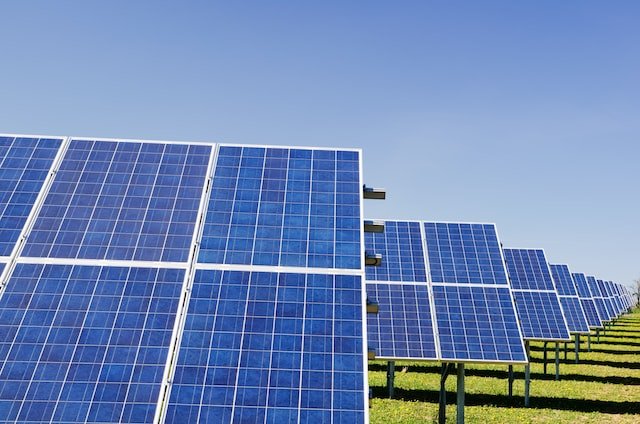Solar panels are liable for producing energy and in maximum instances, they’re positioned on the roof of any building. Hence it is through these solar panels that the real story starts and solar energy receives transformed into energy. These solar panels additionally called the modules are usually southern-faced for maximum potential and energy production.
Each of these solar panels is made from a special layer of silicon cells, a metal frame, and a glassed casing that’s further surrounded by special film and wiring. For most electricity production, the solar panels are organized together into “arrays”. This is through these solar cells additionally called photovoltaic cells, in which the daylight is absorbed in the course of the daylight hours.

Conversion of absorbed solar energy into electrical energy
- Photovoltaic means light and electricity and hence installing these solar cells or photovoltaic cells is the primary initial step to converting solar energy.
- Each Solar cell has a thin semiconductor wafer that’s made from layers of silicon. Now silicon is an evidently occurring chemical element, one of the finest semiconductors. Silicon semiconductors can act as both conductors as well as insulators.
- One silicon layer is positively charged called the N-type and the other silicon layer is negatively charged called the P-type. N-type gives away electrons easily while on the other side P-side semiconductor gets more electrons in the electric field. This positive and negative layer as a result compliments the formation of an electric-powered field at the solar panel.
- We all recognize that energy from the solar comes on this planet in the form of little packets known as photons When the daylight moves those photovoltaic cells already form an electric field, and the photons of daylight startle the electrons internal those cells activating them to begin flowing.
- These free electrons that begin flowing on the electrical area, in addition, create the electrical current.
how does solar energy work?
work of solar work, Solar panels are made out of photovoltaic cells that convert the sun’s energy into electricity.
Photovoltaic cells are sandwiched between layers of semiconducting materials such as silicon. every layer has completely different electronic properties that energize once hit by photons from sunlight, creating an electrical field. this can be referred to as the photoelectric impact – and it’s this that makes the current required to provide electricity.
Solar panels generate an instantaneous current of electricity. this can be then passed through as an inverter to convert it into an alternating current, which can be fed into the National Grid or utilized by the house or business the solar panels are connected to.
How does electrical energy gets converted for usage?
The electric energy which we get from solar energy through photovoltaic cells is generally called Direct current (DC) electricity. But this direct current power can not be used to strengthen houses and buildings, consequently, to utilize this generated electrical energy, we want to transform it into Alternating current (AC) power.
Further to transform Direct current into alternating current special solar inverters need to be installed. In modern solar systems, these investors can be configured as one of the inverters for the whole device, or micro-mini inverters need to be connected behind the panels.

The inverter turns DC energy to one hundred twenty volts AC that may be similarly positioned into immediate use for the house appliances. The power produced by solar energy initially passes through the electric panel in your home after which passes out into the electric grid. When in the case your solar plant is producing more energy than your immediate consumption, your utility meter will turn backward.
Once your DC gets converted to AC, the current then runs through your electric panel installed in your house and therefore supplies energy to all the house appliances. The power generated withinside the sun-strength device is the identical power generated through the grid by your electric utility company; therefore no adjustments in the home are required to get power from solar energy.
Advantages of solar energy
There is 14.6GW of installed solar within the United Kingdom – that’s more than fourfold the capacity of Britain’s largest fuel power station. The panels can be installed in an exceedingly wide selection of places.
From larger, countryside solar farms which will support native biodiversity by providing an undisturbed home ground for bees, butterflies, and nesting birds, to rooftop panels in city centers that can help combat fuel poverty.
They don’t produce any sound pollution while generating electricity. this implies that installations aren’t intrusive – whether or not they’re in crowded urban locations or quiet rural ones.
Solar panels are terribly safe. They’re largely made of silicon sheets, and there’s no danger of the photovoltaic cells leaky or emitting any toxins or fumes.
Disadvantages of solar energy
Solar panels generate the maximum power while the Sun is shining. They don’t work as properly on cloudy days. They additionally work better while they’re positioned in the direction of the equator due to the fact the sun shines more directly on them and in the summertime season here in the Northern hemisphere.
Solar farms want a lot of land. This is land that might be used for different such things as wildlife habitats or farms. Solar panels aren’t excellent at changing daylight to power. Most solar panels are approximately 20�f. In that method only 20% of the sun’s strength, collects is transformed into electric strength.
But even this is a massive development on the way it became only ten years ago and there’s more good information on the horizon. A new solar panel has reached forty-seven percent efficiency in the lab and nearly forty percent in the field. This means the future of solar electricity generation could be very bright.
